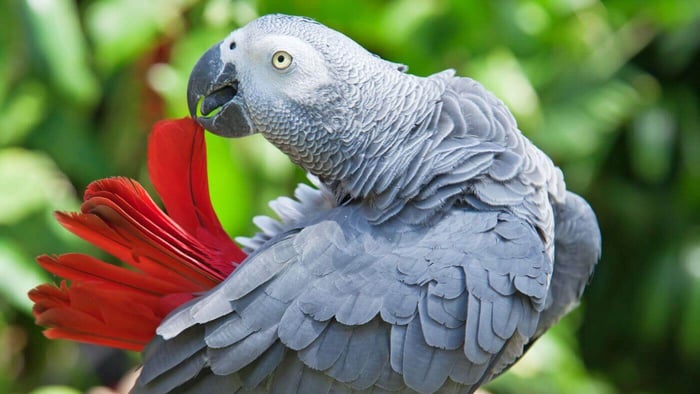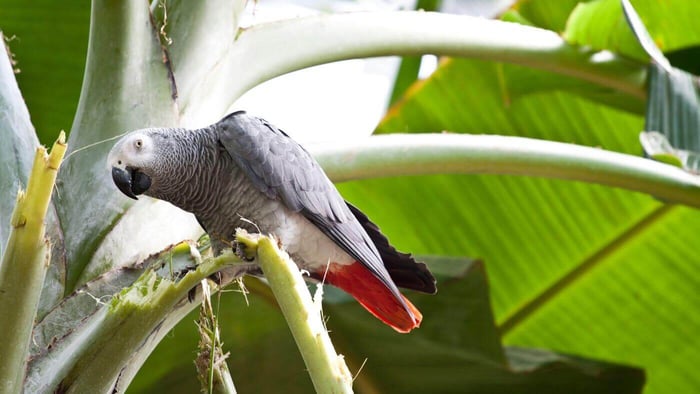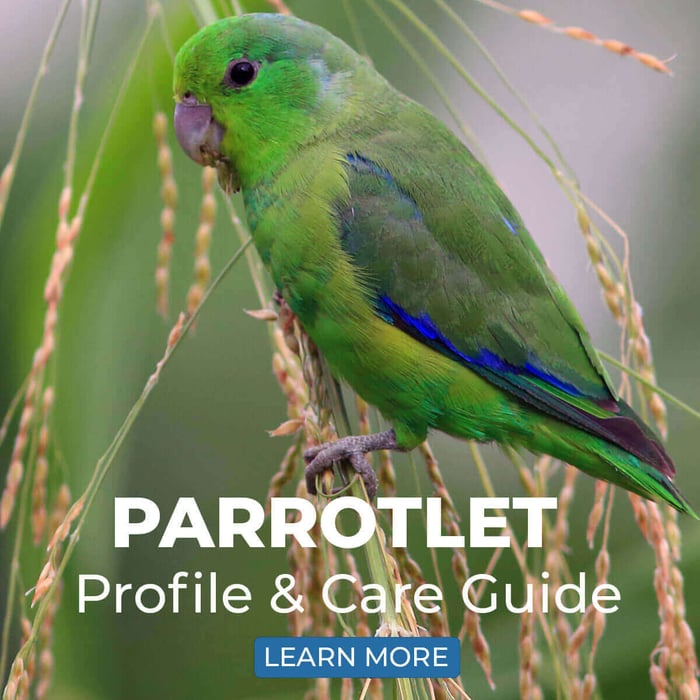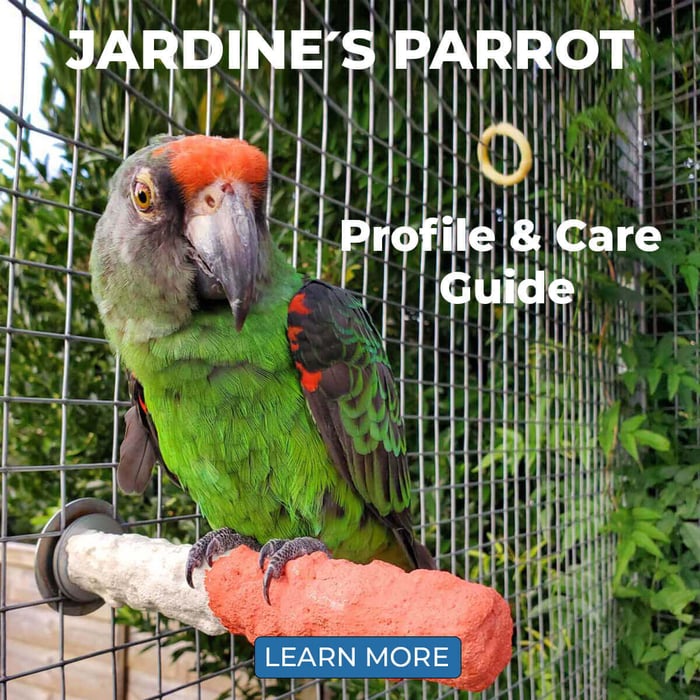Congo African Grey Parrot Profile & Care Guide
| Common name: | Congo African Grey Parrot |
| Scientific name: | Psittacus erithacus |
| Length: | 33 cm/13 inches |
| Weight: | 400-600 grams |
| Lifespan: | 50+ years |
| Origin: | Central Africa, Tanzania, Western Kenya |
| Noise Level: | Medium |
NATURAL HABITAT

The Congo African Grey parrot is naturally found in Central Africa, right around the equator. Its range includes countries like Angola, Burundi, Cameroon, and, of course, the Democratic Republic of the Congo (hence the name).
In the wild, this medium-sized parrot prefers dense rainforests. These habitats offer safety, hollow trees to roost and nest in, plus plenty of the fruits and seeds the species likes to feed on. It lives in large groups that can sometimes contain thousands of birds and tend to forage on the ground for foods like oil palm nuts.
CONGO AFRICAN GREY INTELLIGENCE & PERSONALITY
Congo African Greys are appreciated as pets not just thanks to their beautiful looks but also their absolutely exceptional intelligence. Their brains are pretty much unparalleled among parrots and other birds. It's sometimes said that African greys possess the intelligence level of a young child, which we're inclined to agree with!
Every grey has its own unique personality, quirks and temperament. Although these birds can be sensitive, scared of new things, and prone to stress, they also tend to be highly observant, chatty, curious, and generally joyful. They have fantastic memories and highly impressive problem-solving skills.
One of the most renowned Congo African Greys was the late Alex, who was researched extensively by Dr. Irene Pepperberg in the USA. Alex's achievements demonstrated these parrots' amazing potential. He could process information, choose appropriate words accurately, and understand concepts like colour and shape. Tragically, Alex passed away at thirty-one, a relatively young age for a healthy African Grey.
Their multifaceted personalities and razor-sharp intellect make Congo African Greys fascinating companions. However, they also mean you need to be ready to care for what is essentially the equivalent of a human toddler for decades to come. These birds can be huge handfuls sometimes!
CONGO AFRICAN GREY TALKING ABILITY
Greys are outstanding mimics renowned for their exceptional talking abilities. Some have a recorded vocabulary of over 2,000 words. Even those that aren't chatty excel at imitating familiar household sounds, like the ring of a telephone or a doorbell. They're so good at it that their owners sometimes have trouble figuring out whether it's the phone or their bird ringing!
Most greys amass a vast repertoire of sounds to mimic, sometimes after hearing them only a few times. Dr Pepperberg's studies with Alex highlighted that greys also have a unique aptitude for contextualizing their words and sounds rather than merely parroting them back. The fact that they seem to be able to understand what they're saying is just another confirmation of this species' amazing intelligence.
FEEDING & SUPPLEMENTS FOR YOUR CONGO AFRICAN GREY
Diversity is essential when it comes to feeding any parrot, and this is no different for African Greys. Formulated pellets should form the core of their diet.
It's important to supplement your bird's meals with a wide range of fresh fruits, vegetables, grains, and proteins. You can also offer seeds, but keep in mind that seed mixes, especially those with a high proportion of sunflower seeds, are too high in fat and low in nutrients to be a primary food source. Parrots can actually become "addicted" to fatty sunflower seeds, causing them to refuse their normal meals!
Introducing new foods can be challenging, as African Greys can be a little apprehensive when it comes to trying new things. Persistence and patience are vital. Try having a look at our article on introducing a parrot to new foods if you're having trouble getting your grey to eat its veggies, fruits or pellets.
African Greys have a predisposition toward calcium deficiency. As such, regular yearly vet checks should include monitoring their calcium levels. Direct calcium supplements should be used only under the guidance of an avian vet. Usually, incorporating calcium-rich foods, like leafy green vegetables — including kale, mustard greens, Swiss chard, and spinach — should be enough.
Ensure fresh, clean water is available to your bird at all times. Clean food and water dishes daily to keep them fresh.
HOUSING FOR YOUR CONGO AFRICAN GREY
Your Congo African Grey will need a large cage that gives it plenty of space to stretch its wings. A recommended minimum size would be approximately 90 cm x 60 cm x 120 cm (length x width x height). Remember, though, that when it comes to parrot housing, bigger is always better!
The cage bar spacing should be between 2-2.5 cm, with 2 cm being ideal if you have a Timneh Grey rather than a Congo. Your bird will appreciate horizontal bars on at least one part of the cage, as parrots love to climb and clamber around their home.
Place the cage in a part of the house that gets some traffic so your African Grey gets plenty of human contact, but avoid spots that are overly busy. Avoid direct sunlight, the kitchen (cooking fumes), and draughty areas. Also, keep it away from central heating or air conditioning vents, which can be harmful. Many parrot owners like to place their bird's cages in the living room.

CAGE DÉCOR
Inside the cage, your parrot should have access to a range of parrot perches, varying in size and material. You can include perches for beak and nail trimming, as well as natural wood perches. It's important to ensure perches are wear-resistant, given their frequent use and the fact that our birds like to chew on them.
Equipping the cage with a diverse set of suitable toys is also very important for your parrot. These toys should be of the right size and routinely checked for potential safety hazards, like swallowable parts or entanglement risks. Regularly rotating a selection of African Grey parrot toys can keep the bird engaged and mentally stimulated.
OUT OF CAGE TIME
Plan to allow your Congo African grey to spend a significant amount of time outside the cage.
Encourage exploration and engagement with its environment during this time.
It's worth investing in a quality play gym for the bird to hang out on while it's out.
Can't let your African Grey out for a few hours a day to play and explore? In that case, you'll have to provide it with a full-sized aviary to make sure it still gets enough exercise, and so it doesn't get bored.
CONGO AFRICAN GREY FEATHER PLUCKING
African Grey parrots are unfortunately known to be susceptible to feather plucking. This behaviour, in its more severe forms, can even escalate to other types of self-mutilation, such as picking at the skin. Causes often include a combination of physical, psychological, and emotional factors. This especially applies if the bird's emotional needs aren't addressed or if it's experiencing stress.
If you think your Congo African Grey is feather plucking, you should take it for an examination by an avian vet to eliminate any physical causes. After all, problems like skin irritation can also lead to a parrot pulling out its own feathers.
Grey parrots' heightened propensity for feather-plucking behaviours likely stems from their high intelligence, which, in turn, generates a pronounced need for attention and stimulation. Remember what we said: they're a little like toddlers, and they need the same amount of attention. Without it, they'll wither.
CONGO AFRICAN GREY FACTS

- Up until 2007, there was only one recognized species in the genus Psittacus. This changed when researchers found that the Timneh African Grey, which was considered a subspecies until that point, deserved elevation to full species status.
- Unfortunately, the IUCN lists the Congo African Grey parrot as an Endangered species. The wild population is still decreasing due to issues such as poaching for the pet trade and habitat loss.
- In October 2016, CITES listed grey parrots under Appendix 1, offering them the highest level of protection. This listing regulates international trade in the species.
- You can tell the difference between Congo and Timneh greys by looking at their beaks and tails. Congo African Grey parrots have black beaks, while a Timneh will have a partially beige or skin-coloured beak. Congo African Grey has red tails, while Timneh has purple tails.
- Wild African Greys are quite secretive. Due to their shy nature and their preference for densely forested habitats, we don't know much about their habits in the wild.
- There are some selectively bred colour variations. Inos (mostly white) Congo African Grey parrot and red factor (red mottling).
CONCLUSION
In summary, Congo African Greys are magnificent and amazing parrots, but they're not the ideal bird for everyone. Potential owners should carefully assess their commitment to these birds' long lifespan.
Consider the responsibilities associated with caring for them for 45 – 50 years. Ensure you understand the proper care for these parrots before bringing one into your family. Prioritise learning about their care needs beforehand.
To view other Parrot Profiles & Care Guides, visit our Alphabetical list of Parrot Fact Sheets by visiting: https://parrotessentials.co.uk/blog/parrot-profiles-care-guides




